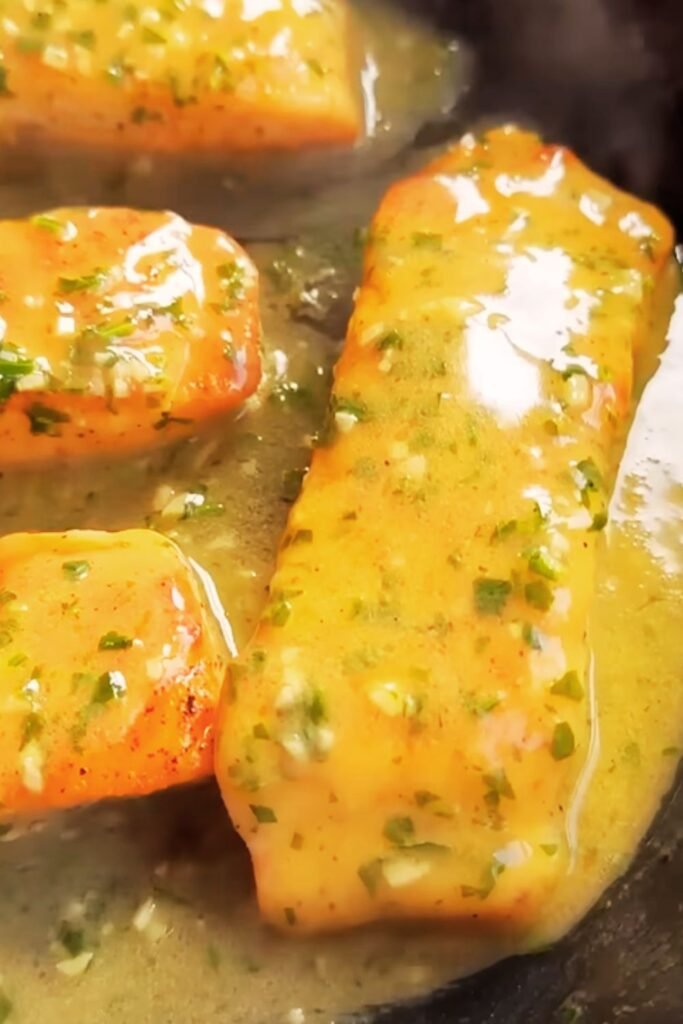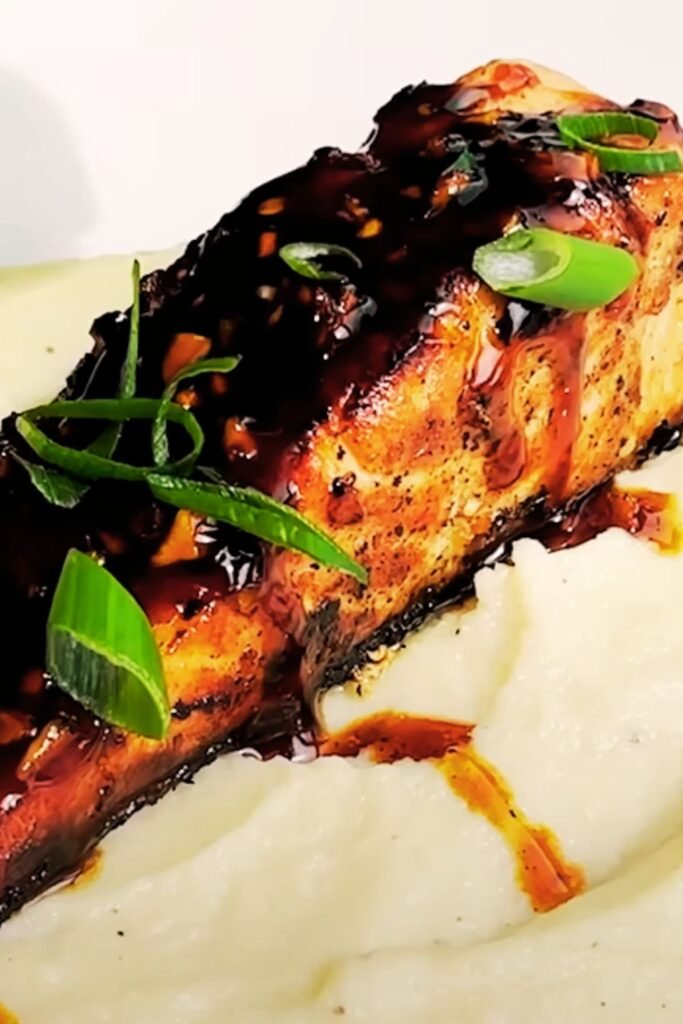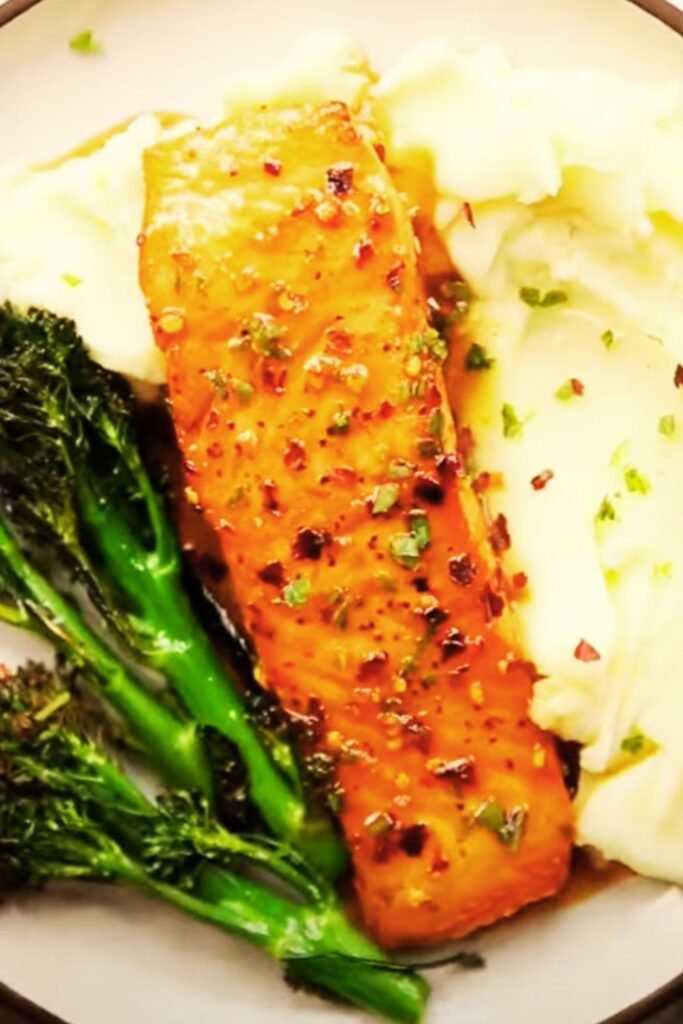I’ll be completely honest with you – I never thought I could make restaurant-quality salmon at home until I discovered this sticky garlic butter salmon recipe. It’s become my go-to dish when I want to impress guests or simply treat myself to something extraordinary on a regular Tuesday evening.
There’s something absolutely magical about the way garlic butter transforms simple salmon into a glossy, caramelized masterpiece. The sticky glaze clings to every flaky piece, creating layers of flavor that dance on your tongue. What makes this recipe even better is how deceptively simple it is to prepare.
Understanding the Magic Behind Sticky Garlic Butter Salmon
Sticky Garlic Butter Sauce : A glossy, caramelized coating made from butter, garlic, brown sugar, and soy sauce that creates a beautiful lacquered finish on salmon
Maillard Reaction : The chemical process that occurs when proteins and sugars in the salmon and sauce caramelize under heat, creating complex flavors and that coveted golden-brown color
Pan-Seared Technique : A cooking method that creates a crispy exterior while maintaining a tender, flaky interior in the salmon
Glaze Reduction : The process of cooking the sauce until it thickens and becomes syrupy, allowing it to coat the salmon beautifully
When I first attempted this recipe, I was amazed by how the simple combination of ingredients could create such depth of flavor. The key lies in understanding how each component works together to create that perfect balance of sweet, savory, and umami notes.
Essential Ingredients for Perfect Sticky Garlic Butter Salmon
For the Salmon
- 4 salmon fillets (6 oz each), skin removed
- 1 teaspoon salt
- 1/2 teaspoon black pepper
- 2 tablespoons olive oil
For the Sticky Garlic Butter Sauce
- 4 tablespoons unsalted butter
- 6 cloves garlic, minced
- 3 tablespoons brown sugar
- 3 tablespoons soy sauce (low sodium preferred)
- 2 tablespoons honey
- 1 tablespoon rice vinegar
- 1/4 teaspoon red pepper flakes
- 2 tablespoons fresh lemon juice
- 2 green onions, chopped (for garnish)
- 1 tablespoon sesame seeds (optional)

Nutritional Benefits: Why This Salmon Dish is Good for You
| Nutrient | Amount per Serving | Health Benefits |
|---|---|---|
| Protein | 35-40g | Muscle building and repair |
| Omega-3 Fatty Acids | 1.8g | Heart health, brain function |
| Vitamin D | 360-600 IU | Bone health, immune support |
| Vitamin B12 | 4.8mcg | Energy metabolism, nervous system |
| Selenium | 40mcg | Antioxidant properties |
| Potassium | 628mg | Heart health, blood pressure regulation |
| Calories | 320-380 | Moderate calorie content |
I love knowing that while I’m indulging in this incredibly flavorful dish, I’m also nourishing my body with high-quality protein and essential fatty acids. Salmon is one of nature’s superfoods, and this preparation method doesn’t compromise its nutritional value.
Step-by-Step Cooking Instructions
Preparing the Salmon
- Remove salmon from refrigerator 15-20 minutes before cooking to bring to room temperature
- Pat salmon fillets completely dry with paper towels
- Season both sides generously with salt and pepper
- Let seasoned salmon rest while you prepare the sauce
Creating the Sticky Garlic Butter Sauce
- In a small bowl, whisk together brown sugar, soy sauce, honey, and rice vinegar
- Set this mixture aside – it will be your flavor base
- Mince garlic finely to ensure even distribution throughout the sauce
- Have all ingredients measured and ready, as the cooking process moves quickly
Cooking Process
Pan Preparation:
- Heat olive oil in a large non-stick or cast-iron skillet over medium-high heat
- Wait until oil shimmers but doesn’t smoke
- This temperature is crucial for achieving the perfect sear
Searing the Salmon:
- Gently place salmon fillets in the hot pan, leaving space between each piece
- Don’t move the salmon for 4-5 minutes – this creates that beautiful golden crust
- Flip carefully using a thin spatula
- Cook for another 3-4 minutes until internal temperature reaches 145°F
- Remove salmon to a plate and tent with foil
Making the Glaze:
- Reduce heat to medium and add butter to the same pan
- Add minced garlic and sauté for 30 seconds until fragrant
- Pour in the brown sugar mixture
- Add red pepper flakes for a subtle heat
- Simmer for 2-3 minutes, stirring constantly
- The sauce should thicken and become glossy
- Stir in lemon juice and remove from heat

Final Assembly:
- Return salmon to the pan and spoon sauce over each fillet
- Let salmon warm through for 1-2 minutes
- The sauce should coat the salmon beautifully
- Garnish with chopped green onions and sesame seeds
Professional Tips for Restaurant-Quality Results
Temperature Control Secrets
I’ve learned that temperature control is absolutely critical for this dish. My digital thermometer has become my best friend in the kitchen. Here’s what I’ve discovered:
- Pan Temperature: Medium-high heat creates the perfect sear without burning the garlic
- Internal Temperature: 145°F ensures perfectly cooked salmon that’s still moist
- Sauce Temperature: Keep it at a gentle simmer to prevent burning the sugars
Timing is Everything
The beauty of this recipe lies in its timing. I always follow this sequence:
- Prep all ingredients first (mise en place)
- Season salmon and let it rest
- Heat pan and sear salmon
- Remove salmon and make sauce in the same pan
- Return salmon for final glazing
Sauce Consistency Mastery
Achieving that perfect sticky consistency took me several attempts to master. The sauce should coat the back of a spoon but still flow freely. If it becomes too thick, I add a tablespoon of water. If it’s too thin, I let it simmer a bit longer.
Cooking Time and Temperature Guide
| Step | Temperature | Time | Visual Cue |
|---|---|---|---|
| Room Temperature Rest | Room temp | 15-20 minutes | Salmon feels less cold |
| First Sear | Medium-high | 4-5 minutes | Golden crust forms |
| Second Side | Medium-high | 3-4 minutes | Internal temp 145°F |
| Sauce Preparation | Medium | 2-3 minutes | Sauce becomes glossy |
| Final Glazing | Low-medium | 1-2 minutes | Sauce coats salmon |
Serving Suggestions That Complement the Flavors
This sticky garlic butter salmon pairs beautifully with sides that can soak up that incredible sauce:
Rice and Grains:
- Jasmine rice perfectly absorbs the extra sauce
- Coconut rice adds a tropical twist
- Quinoa provides a nutty, protein-rich base
- Brown rice offers a heartier texture
Vegetable Companions:
- Steamed broccoli with a drizzle of the pan sauce
- Roasted asparagus seasoned with garlic
- Sautéed baby bok choy
- Grilled zucchini and bell peppers
Starch Options:
- Garlic mashed potatoes
- Roasted sweet potato wedges
- Buttered egg noodles
- Cauliflower rice for a low-carb option

Storage and Reheating Guidelines
I often make extra because the leftovers are almost as good as the fresh version:
Refrigeration
- Store in airtight container for up to 3 days
- Keep sauce and salmon together to maintain moisture
- Label with date for food safety
Reheating Methods
Oven Method (Recommended):
- Preheat oven to 275°F
- Place salmon in baking dish
- Cover with foil
- Heat for 10-12 minutes
Microwave Method:
- Use 50% power setting
- Heat in 30-second intervals
- Check temperature frequently
Stovetop Method:
- Use low heat
- Add a splash of water or broth
- Cover and warm gently
Variations and Flavor Modifications
Spice Level Adjustments
- Mild: Omit red pepper flakes
- Medium: Use as written
- Spicy: Add 1/2 teaspoon sriracha to the sauce
- Extra Hot: Include fresh minced jalapeño
International Flavor Twists
Asian-Inspired:
- Add 1 teaspoon fresh ginger
- Include 1 tablespoon mirin
- Garnish with cilantro instead of green onions
Mediterranean Style:
- Replace soy sauce with balsamic vinegar
- Add fresh thyme and oregano
- Finish with fresh basil
Tropical Variation:
- Add 1 tablespoon pineapple juice
- Include 1/2 teaspoon ground ginger
- Garnish with toasted coconut flakes
Troubleshooting Common Issues
Problem: Sauce Won’t Thicken
Solution: Continue simmering while stirring constantly. The sugars need time to caramelize.
Problem: Salmon Sticks to Pan
Solution: Ensure pan is properly heated and don’t move salmon too early. A proper sear naturally releases.
Problem: Garlic Burns
Solution: Reduce heat immediately and add the liquid mixture quickly to stop the cooking process.
Problem: Sauce is Too Sweet
Solution: Balance with additional lemon juice or a splash of rice vinegar.
Problem: Salmon Overcooked
Solution: Remove from heat immediately. The residual heat will continue cooking.
Ingredient Substitutions and Alternatives
| Original Ingredient | Substitution | Notes |
|---|---|---|
| Brown Sugar | Coconut sugar, maple syrup | Adjust quantity for sweetness level |
| Soy Sauce | Tamari, coconut aminos | For gluten-free option |
| Honey | Agave nectar, brown sugar | Maintain sweetness balance |
| Rice Vinegar | Apple cider vinegar | Use slightly less |
| Salmon | Arctic char, trout | Adjust cooking time for thickness |
| Sesame Seeds | Crushed almonds | For nut-free, use pumpkin seeds |
Food Safety and Handling Tips
When working with salmon, I always prioritize food safety:
Purchase and Storage:
- Buy from reputable sources
- Check for bright color and fresh smell
- Use within 2 days of purchase
- Keep refrigerated at 40°F or below
Preparation Safety:
- Wash hands thoroughly before and after handling
- Use separate cutting boards for fish
- Clean all surfaces with bleach solution
- Don’t cross-contaminate with other foods
Cooking Safety:
- Cook to internal temperature of 145°F
- Use a reliable meat thermometer
- Don’t partially cook and finish later
- Serve immediately after cooking
Nutritional Comparison with Other Salmon Preparations
| Preparation Method | Calories | Fat (g) | Sodium (mg) | Added Sugar |
|---|---|---|---|---|
| Sticky Garlic Butter | 380 | 22 | 650 | 9g |
| Grilled Plain | 280 | 18 | 80 | 0g |
| Teriyaki Glazed | 420 | 20 | 890 | 15g |
| Lemon Herb Baked | 320 | 20 | 320 | 0g |
| Blackened Cajun | 310 | 19 | 780 | 0g |
While this preparation does add some calories and sodium, the flavor payoff is absolutely worth it for special occasions or when you want to treat yourself.
Questions and Answers
Q: Can I use frozen salmon for this recipe? A: Yes, but make sure to thaw it completely first. Pat it extra dry as frozen salmon releases more moisture. I recommend thawing in the refrigerator overnight for best results.
Q: How do I know when the salmon is perfectly cooked? A: The salmon should flake easily with a fork and reach an internal temperature of 145°F. It should be opaque throughout but still moist. Overcooked salmon becomes dry and tough.
Q: Can I make the sauce ahead of time? A: Absolutely! I often make the sauce components and store them separately. You can whisk together the brown sugar mixture up to 3 days ahead. Just make the final sauce fresh when cooking.
Q: What’s the best type of salmon to use? A: I prefer Atlantic or King salmon for their rich flavor and higher fat content. Coho salmon works well too. Wild-caught generally has better flavor than farmed, but both work in this recipe.
Q: My sauce separated – can I fix it? A: If the sauce separates, remove it from heat and whisk in a tablespoon of cold water or lemon juice. This usually brings it back together. Prevention is key – don’t let it get too hot.
Q: Can I cook this in the oven instead of on the stovetop? A: Yes! Sear the salmon in an oven-safe pan, then finish in a 400°F oven for 6-8 minutes. Make the sauce on the stovetop and pour over the finished salmon.
Q: How do I prevent the garlic from burning? A: Keep the heat at medium when making the sauce, and have your liquid mixture ready to add quickly. Minced garlic cooks very fast, so timing is crucial.
Q: Can I double this recipe for a dinner party? A: Absolutely! Use a larger pan or cook in batches. The sauce recipe doubles perfectly. Just make sure not to overcrowd the pan when searing the salmon.
Q: What should I do if I don’t have brown sugar? A: You can substitute with white sugar mixed with a little molasses, or use coconut sugar. Maple syrup works too, but reduce the honey slightly to compensate for the extra liquid.
Q: Is this recipe keto-friendly? A: The salmon itself is perfect for keto, but the sauce contains sugars. You could modify it by using a sugar substitute like erythritol, though the texture might be slightly different.
This sticky garlic butter salmon has become one of my signature dishes, and I’m confident it will become one of yours too. The combination of technique and flavor creates something truly special that transforms an ordinary dinner into an extraordinary experience. Whether you’re cooking for family or entertaining guests, this recipe delivers restaurant-quality results every single time.